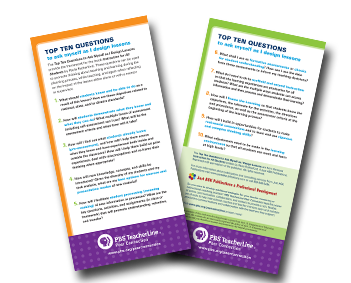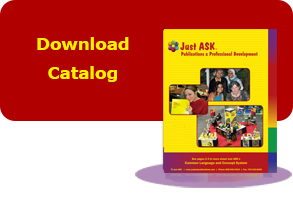
Volume IX Issue X
Share this newsletter on
Formative Assessment FAQs

Bruce facilitating a Leading the Learning® workshop
During the years that Just for the ASKing! has been published, assessment has been the focus multiple times. The issues addressing assessment can be found in the Just for the ASKing! Library under the category of Making Assessment a Learning Experience.
One component of our assessment repertoire that continues to be elusive for many is formative assessment. Questions that frequently surface are addressed in this issue. Those questions include:
- What specifically is formative assessment?
- How does formative assessment differ from summative assessment?
- What does the research tell us about formative assessments?
- How should we apply these research findings to their instructional practice?
- Should formative assessments be included in a student’s report card grade?
- How often should formative assessments be used?
- How should we go about using formative assessments to gather achievement data and what are some strategies we can use?
What specifically is formative assessment?
Formative assessment, as defined by the Council of Chief School Officers, is a “process used by teachers and students during instruction that provides feedback to adjust ongoing teaching and learning, to improve students’ achievement on intended instructional outcomes.” Putting it succinctly, formative assessments provide information, often informal, for both teacher and students about how learning is progressing; concurrently, it informs the teacher about whether or not instruction is working and if true learning is being formed.
How does formative assessment differ from summative assessment?
Formative assessments give teachers the opportunity to provide feedback to students so they can use this data to make corrections or adjustments in their work. Formative assessments let teachers and students know how learning is progressing; summative assessments, on the other hand, are periodically administered to students to determine what knowledge they have learned or what skills students have mastered. Dr. James Popham, a UCLA professor and a huge proponent of the proper use of formative assessment, has said, “Whereas formative assessment intends to improve ongoing assessment, summative assessment tries to answer the question, ‘Was instruction effective?’” Rick Stiggins, President of Assessment Training Institute, Inc., distinguishes between assessments for learning (formative assessment) versus assessment of learning (summative assessment). Stiggins notes that both assessment practices are essential but many educators still do not use formative assessment data properly. Any assessment can be either formative or summative. The category into which an assessment falls is determined by how the information gleaned from the assessment is used.
What does research tell us about formative assessments?
In 1998, British researchers Paul Black and Dylan William published an extensive review of classroom assessment practices and concluded that when properly applied, formative assessment had a significant impact on student learning. In their meta-analysis, they found that gains in learning through the use of formative assessments are “among the largest ever reported for educational interventions.” As the work of Black and William received increased public attention, dialogue in schools also increased as educators contemplated how their current practice compared to the research findings.
How should we apply these research findings to our instructional practice?
There are many justifications for changing one’s thinking about how we assess our student’s progress. Currently, in many grade books, there is a hodgepodge of marks including grades for homework, behavior, participation, attendance, pop quizzes, tardies, and group work. Mixed in with these marks are grades for tests, projects, performance tasks, presentations, essays, book reports, and self-assessments. When determining a report card grade, some teachers combine all of these measures (often weighting different data sources and then averaging everything together) and come up with a letter grade. Unless there are faculty discussions about assessment practices that lead to some uniformity in how schools determine and report student achievement, each staff member can have his own personal and unique system for determining exactly what a specific grade signifies. Hence, grades on report cards vary from teacher to teacher and tell us nothing about what students have actually learned.
Should formative assessments be included in a students’ report card grade?
Current work in the field of assessment provides much greater insight into how we should monitor and report student achievement. Many educational researchers and writers have concluded that a student’s grade should be based on the student’s demonstration of mastery of the learning standards. More precisely, performance on summative assessments should determine a final quarter or annual grade. Formative assessments should be thought of as steps in the learning process; this formative data should be used to provide feedback to students, allow students to adjust their learning strategies, and inform teachers as to how they can adjust instruction to improve learning. It is much like when an athlete or musician learns a new technique; they do not use it instantly in a performance or competition. Instead, the teacher or coach observes the students using the new technique and provides suggestions for improvement until the athlete or musician demonstrates improvement and competence in their quest for mastery. In the same vein, our students should complete self-assessments on work in progress comparing their current proficiency level with a published rubric or a clearly delineated standard. Using the gathered data, the student can identify areas of strength, target areas for improvement, and make an action plan. Practices such as giving a pop quiz or assigning a brief writing assignment, collecting and grading papers and returning the work with a single letter grade on top should be eliminated completely. Using formative assessment data to provide opportunities for growth makes so much more sense if student improvement and learning is the ultimate goal.
How often should formative assessments be used?
From the time students walk in the door, formative assessment is available. Every comment, look, and move provides data about the learners and their learning. Wise teachers are continuously gathering and using that data. Additionally, these wise teachers are purposeful in orchestrating tasks and interactions on a regular ongoing basis that let them know if instruction is working. As University of Virginia Professor Carol Ann Tomlinson has written, “We need to understand where our students are at any point during a unit; in other words, what each student knows, understands, and can do at a given time based on the content goals we’ve established.” Finding out where each student stands in relation to the identified standards can be determined in a variety of ways that do not have to be complex or time consuming.
How should we go about using formative assessments to gather achievement data and what are some strategies/techniques they can use?
As stated above, any interaction between teacher and student can be considered a formative assessment. These interactions may be oral or in writing, can be formal or informal, and can provide data about a student’s progress toward achieving mastery of identified standards. There are dozens of formative assessment strategies. A few possibilities are:
- Ticket to Enter: As students enter the classroom, they are asked to complete a quick response to a question or writing prompt to activate their current thinking on a topic
- Ticket to Leave: Students respond in writing to questions or prompts to show what they have learned and submit the slip to the teacher as they leave the class
- Journaling/Learning Log/Quick Write: Students record their reactions to new learning in a variety of ways
- Self-assessment: Students complete personal assessments indicating where they see themselves with a work in progress
- Two Stars and a Wish: Students provide feedback to a peer by pointing out two positive aspects of the peer’s work followed by one suggestion to help improve their work in the future
- 3-2-1: Students record their summarizing responses at the end of a lesson; for example, the students write about 3 new things they learned, 2 questions they still have, and 1 way they connected their new learning to what they already knew
- One Word Summary: Students choose one word that summarizes the concept or topic they have studied in class followed by 2-3 sentences that explain why they chose the word
- Graphic Organizers: Students complete a visual representation of their learning
- Sentence stem: Students begin a paragraph summary with a sentence stem provided by the teacher such as “The important thing about…” The students then include details to support the conclusion they reached
- Whiteboards: Students write answers/responses on small handheld whiteboards and display them for teacher and classmates to see
- Sticks: The teacher places a craft stick with the name of a student on each one in a container, draws out one stick at a time and asks the designated student a question
- Clipboard Cruising: The teacher moves around the room as students are working individually or in groups and jots down observations about how students are progressing toward mastering an objective
- 10:2 Theory (Rowe): After ten minutes of instruction, the teacher provides two minutes of time for students to pause and process what they have learned during large group instruction; the teacher observes/listens in on student conversations
It is important to note that none of these assessments are graded; they simply provide important data as learning is taking place. When teachers use formative assessments to appropriately analyze students’ day-to-day performance and the effectiveness of the instructional program, the results on summative assessments should be predictable. No one should be surprised. Education Week blogger David Ginsburg says it well when he writes, “Formative assessment efficiency on the part of teachers is the key to summative assessment proficiency on the part of students.”
Just ASK Resources
on Formative Assessment
Access the Just for the Asking! issues that focus on assessment in the Just for the ASKing! Library
- Assessment and Grading: Point/Counterpoint
- Assessment and Grading: Point/Counterpoint II
- Common Assessments: Uncommon Results
- Growth-Producing Feedback
- It’s a Feedback World
- Making the Case for Standards-Based Grading
- Moving Out of the Assessment Dark Ages
- Rethinking Assessment Practices
- The Homework Dilemma
- When Students Don’t Learn
See also :
Check out Sneak Peeks of the above books and archived issues of Just for the ASKing! at www.justaskpublications.com/just-ask-resource-center/
Permission is granted for reprinting and distribution of this newsletter for non-commercial use only. Please include the following citation on all copies:
Oliver, Bruce. “Formative Assessment FAQs” Just for the ASKing! October 2012. Reproduced with permission of Just ASK Publications & Professional Development (Just ASK). © 2012 Just ASK. All rights reserved. Available at www.justaskpublications.com.
Free Top Ten Tips to Ask Myself as I Design Lessons
“These questions can be used to promote thinking about teaching and learning during the planning process, while teaching, and again when reflecting on the impact of the lesson either alone or with a mentor or supervisor.”




